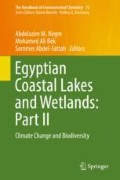Abstract
Northern coastal zone of Egypt hosts lakes with distinguished characteristics. Earlier, certain coastal lakes were acknowledged as nature reserve, with their rich aquatic environment as well as playing a hosting role to migratory birds. However, maintained conditions with ever-expanding development activities are a challenge. This chapter addresses aspects in the changing structure of coastal lakes; governing factors responsible for the declining dynamic system. Hence, challenges with sustainability and capacity to recover are discussed. As remote sensing techniques proved cost-effective tool, with reasonable accuracy, for monitoring temporal and spatial changes, an application is presented to a case study of the deltaic coastal lake, Lake Burullus. Among the wide information that can be derived from satellite imageries, water quality index is selected as a key indicator to gain insight into evolving environmental state of the coastal lake. Finally, the chapter discusses proposed strategies to regain efficient functionality and sustainable beneficial uses of coastal lakes, while considering applicability.
References
Abayazid H (2015) Assessment of temporal and spatial alteration in coastal lakes – Egypt. In: Proceedings of the eighteenth International Water Technology Conference 2015 (IWTC 2015), Sharm El Sheikh, 12–14 Mar 2015, pp 598–608
Abayazid H, Al-Shinnawy I (2012) Coastal lake sustainability: threats and opportunities with climate change. J Mech Civil Eng Int Organ Sci Res (JMCE/IOSR) 1(5):33–41
Ahmed S, Kaiser M (2014) Monitoring water pollution of lake mariout on the Mediterranean coast of Egypt. Int J Remote Sens Appl 4(1):36–40. https://doi.org/10.14355/ijrsa.0401.03
Dewidar K, Khedr AA (2005) Remote sensing of water quality for Burullus Lake, Egypt. Geocarto Int 20(3):43–49
The Egyptian Environment Affairs Agency (EEAA) (2003) Al-Burullus wetland’s hydrological study. Natural Protectorates Central Administration Press, pp 1–18
El-Kafrawy SB, Khalafallah A, Omar M, Khalil MMH, Yehia A, Allam M (2015) An integrated field and remote sensing approach for water quality mapping of Lake Burullus, Egypt. Int J Environ Sci Eng (IJESE) 6:15–20
Farag H, El-Gamal A (2012) Assessment of the eutrophic status of Lake Burullus (Egypt) using remote sensing. Int J Environ Sci Eng (IJESE) 2:61–74
Hereher ME, Salem MI, Darwish DH (2010) Mapping water quality of Burullus lagoon using remote sensing and geographic information system. J Am Sci 7(1):138–143
El-Adawy A, Negm AM, Elzeir MA, Saavedra OC, El-Shinnawy IA, Nadaoka K (2013) Modeling the hydrodynamics and salinity of el-Burullus Lake (Nile Delta, northern Egypt). J Clean Energy Technol 1(2):157–163
Saad El-Din M, Gaber A, Koch M, Ahmed RS, Bahgat I (2013) Remote sensing application for water quality assessment in Lake Timsah, Suez Canal, Egypt. J Remote Sens Technol 1(3):61–74
Rostom NG, Shalaby AA, Issa YM, Afifi AA (2017) Evaluation of Mariut Lake water quality using hyperspectral remote sensing and laboratory works. Egypt J Remote Sens Space Sci 20(Suppl 1):S39–S48
Embabi NS, Moawad MB (2014) A semi-automated approach for mapping geomorphology of el Bardawil Lake, northern Sinai, Egypt, using integrated remote sensing and GIS techniques. Egypt J Remote Sens Space Sci 17:41–60
Anderson JD (2007) Fundamentals of aerodynamics4th edn. McGraw-Hill, New York
Brutsaert W (2005) Hydrology – an introduction. Cambridge University Press, New York
Chapra SC (1997) Surface water-quality modeling. McGraw-Hill, New York
Thomann RV, Mueller JA (1987) Principles of surface water quality modeling and control. HarperCollins, New York
Deltares (2011) Delft3D-FLOW: simulation of multi-dimensional hydrodynamics flows and transport phenomena, including sediments. User manual version 3.15. Deltares, Delft
Donia N, Bahgat M (2016) Water quality management for Lake Mariout. Ain Shams Eng J 7:527–541
Jones HFE, Hamilton DP (2014) Hydrodynamic modelling of Lake Whangape and Lake Waahi. Waikato Regional Council technical report 2014/24
Chang N, Imen S, Vannah B (2015) Remote sensing for monitoring surface water quality status and ecosystem state in relation to the nutrient cycle: a 40-year perspective. Crit Rev Environ Sci Technol 45:101–166
Wu C, Wu J, Qi J, Zhang L, Huang H, Lou L, Chen Y (2010) Empirical estimation of total phosphorous concentration in the mainstream of the Qiantang River in China using landsat TM data. Int J Remote Sens 31(9):2309–2324
Brown RM, McClelland NI, Deininger RA, O’Connor MF (1972) A water quality index crashing the psychological barrier. Indicators Environ Qual 1(1):173–178
Brown RM, McClelland NI, Deininger RA, Tozer RG (1970) A water quality index – do we dare? In: National symposium on data and instrumentation for water quality management & water and sewage works
Canadian Council of Ministers of the Environment (CCME) (2001) Canadian Water Quality Index 1.0 technical report and user’s manual. Canadian environmental Quality Guidelines Water Quality Index Technical Subcommittee, Gatineau
Stoner JD (1978) Water-quality indices for specific water uses. Geol Surv Circ 770:1–12
Doumont H, El-Shabrawy G (2007) Lake Burullus of the Nile Delta: a short history and uncertain future. R Swed Acad Sci Ambio 36(8):677–682
Perrie SM, Milne JR, Greenfield S (2012) Greater Wellington Regional Council, Environmental Monitoring and Investigations Department, GW/EMI-T-pp.12/143. ISBN: 978-1-927217-13-9 (online)
Liu Y, Islam MA, Gao J (2003) Quantification of shallow water quality parameters by means of remote sensing. Prog Phys Geogr 27(1):24–43
Akbar T, Hassan Q, Achari G (2010) A remote sensing based framework for predicting water quality of different source waters. Int Arch Photogramm Remote Sens Spat Inf Sci 34. Part XXX
Abayazid H, El-Gamal A (2017) Employing remote sensing for water clarity monitoring in the Nile Delta Coast. IWTJ, IAWT. (in press)
Author information
Authors and Affiliations
Corresponding author
Editor information
Editors and Affiliations
Rights and permissions
Copyright information
© 2017 Springer International Publishing AG
About this chapter
Cite this chapter
Abayazid, H. (2017). Changes in a Coastal Lake Dynamic System and Potential Restoration. In: Negm, A., Bek, M., Abdel-Fattah, S. (eds) Egyptian Coastal Lakes and Wetlands: Part II. The Handbook of Environmental Chemistry, vol 72. Springer, Cham. https://doi.org/10.1007/698_2017_104
Download citation
DOI: https://doi.org/10.1007/698_2017_104
Published:
Publisher Name: Springer, Cham
Print ISBN: 978-3-319-93610-9
Online ISBN: 978-3-319-93611-6
eBook Packages: Earth and Environmental ScienceEarth and Environmental Science (R0)

